Royal Naval Reserve
The Royal Naval Reserve (RNR) is one of the two volunteer reserve forces of the Royal Navy in the United Kingdom. Together with the Royal Marines Reserve, they form the Maritime Reserve. The present RNR was formed by merging the original Royal Naval Reserve, created in 1859, and the Royal Naval Volunteer Reserve (RNVR), created in 1903. The Royal Naval Reserve has seen action in World War I, World War II, the Iraq War, and Afghanistan.
| Royal Naval Reserve | |
|---|---|
| Active | 1859–present |
| Country | |
| Allegiance | |
| Branch | |
| Type | Naval reserve |
| Role | Volunteer Reserve |
| Website | Royal Naval Reserve |
| Commanders | |
| Flag Officer Reserves | Rear Admiral Philip Hally |
| Commodore-in-Chief | Prince Michael of Kent, GCVO |
| Insignia | |
| White Ensign |  |
| Naval Jack |  |
 |
| Her Majesty's Naval Service of the British Armed Forces |
|---|
| Components |
|
|
| History and future |
| Ships |
| Personnel |
|
|
| Auxiliary services |
History
Establishment
The Royal Naval Reserve (RNR) has its origins in the Register of Seamen, established in 1835 to identify men for naval service in the event of war, although just 400 volunteered for duty in the Crimean War in 1854 out of 250,000 on the Register.[1] This led to a Royal Commission on Manning the Navy in 1858, which in turn led to the Naval Reserve Act of 1859. This established the RNR as a reserve of professional seamen from the British Merchant Navy and fishing fleets, who could be called upon during times of war to serve in the regular Royal Navy. The RNR was originally a reserve of seamen only, but in 1862 was extended to include the recruitment and training of reserve officers. From its creation, RNR officers wore on their uniforms a unique and distinctive lace consisting of stripes of interwoven chain.
.jpg)
A number of drill-ships were established at the main seaports around the coasts of Great Britain and Ireland, and seamen left their vessels to undertake gunnery training in a drill-ship for one month every year. After initial shore training, officers embarked in larger ships of the Royal Navy's fleet (usually battleships or battle cruisers) for one year, to familiarise themselves with gunnery and naval practice. Although under the operational authority of the Admiral Commanding, Reserves, the RNR was administered jointly by the Admiralty and the Registrar General of Shipping and Seamen at the Board of Trade throughout its separate existence. In 1910, the RNR (Trawler Section) was formed to recruit and train fishermen for wartime service in minesweepers and other small warships.
Officers and men of the RNR soon gained the respect of their naval counterparts with their professional skills in navigation and seamanship, and served with distinction in a number of conflicts including the Boer War and the Boxer Rebellion. Prior to the First World War, one hundred RNR officers were transferred to permanent careers in the regular navy—later referred to as "the hungry hundred". In their professional careers, many RNR officers went on to command the largest passenger liners of the day and some also held senior positions in the shipping industry and the government.
Volunteer Reserve
At the turn of the 20th century, there were concerns at the Admiralty and in parliament that the RNR was insufficient to bolster the manning of the greatly-expanded fleet in the event of large-scale war. Despite the huge growth in the number of ships in the British merchant service since the RNR's foundation, many of the additional seamen were from the colonies or were not British subjects. The pool of potential RNR officers had shrunk since 1859 and experience in the Boer War showed that it would not be possible to call up a sufficient number of reservists without negatively impacting the work of the merchant and fishing fleets. In 1903 an Act of Parliament was passed enabling the Admiralty to raise a second reserve force – the Royal Naval Volunteer Reserve. While the RNR consisted of professional civilian sailors, the RNVR was open to civilians with no prior sea experience. By the outbreak of the First World War there were six RNVR divisions in major ports around the UK.[2]
First World War
.jpg)
On mobilisation in 1914, the RNR consisted of 30,000 officers and men. Officers of the permanent RNR on general service quickly took up seagoing appointments in the fleet, many in command, in destroyers, submarines, auxiliary cruisers and Q-ships. Others served in larger units of the battle fleet including a large number with the West Indies Squadron who became casualties at the Battle of Coronel and later at Jutland. Fishermen of the RNR(T) section served with distinction on board trawlers fitted out as minesweepers for mine clearance operations at home and abroad throughout the war, where they suffered heavy casualties and losses. One such casualty was armed naval drifter HMT Frons Olivae, which hit a mine off Ramsgate on 12 October 1915 in an explosion that killed at least five other seamen. One casualty, a Newfoundlander serving with the Royal Naval Reserve, was subsequently buried in the Hamilton Road Cemetery, Deal, Kent.[3]
A number of RNR officers qualified as pilots and flew aircraft and airships with the Royal Naval Air Service, whilst many RNR ratings served ashore alongside the RN and RNVR contingents in the trenches of the Somme and at Gallipoli with the Royal Naval Division. Merchant service officers and men serving in armed merchant cruisers, hospital ships, fleet auxiliaries and transports were entered in the RNR for the duration of the war on special agreements.
Although considerably smaller than both the RN and the RNVR (which was three times the size of the RNR at the end of the War), the RNR had an exceptional war record, members being awarded twelve Victoria Crosses.
Second World War
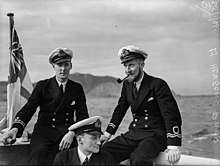
On commencement of hostilities in the Second World War, the RN once again called upon the experience and professionalism of the RNR from the outset to help it to shoulder the initial burden until sufficient manpower could be trained for the RNVR and 'hostilities only' ratings. Again, RNR officers found themselves in command of destroyers, frigates, sloops, landing craft and submarines, or as specialist navigation officers in cruisers and aircraft carriers. In convoy work, the convoy commodore or escort commander was often an RNR officer. As in the First World War, the RNR acquitted itself well, winning four VCs.
On the outbreak of the Second World War, no more ratings were accepted into the RNVR and new intake to the RNR stopped. The RNVR became the route by which virtually all new-entry commissioned officers joined the naval service during the war – the exception being professional mariners who already held master's tickets, who would join the RNR.[4] All new ratings would go direct to the regular Royal Navy. An intermediate form of reserve, between the professional RNR and the civilian RNVR, had been created in 1936. This was the Royal Naval Volunteer (Supplementary) Reserve, open to civilians with existing and proven experience at sea as both ratings and officers. In peacetime this carried no obligation or requirement for service or training, being merely a register of people who could be mobilised and trained swiftly in the event of war to quickly provide a core of new personnel. By September 1939 there were around 2000 RNV(S)R members, mostly yachtsmen, who when mobilised were sent to active service after a 10-day training course while the RNVR began with a regular 12-week course for officers.
By 1945 there were 43,805 officers in the RNVR, which was colloquially called the "Wavy Navy", after the 3/8-inch wavy sleeve 'rings' that officers wore to differentiate them from their RN and RNR counterparts.[5] By Command of King George VI in 1952, these were replaced by the straight rank lacing used in the full-time RN, with the addition of a small 'R' in the centre of the executive curl on cuff and epaulette insignia. From 30 November 2007, mainly due to increasing involvement of the RNR in RN operations and deployments, the wearing of the distinctive 'R' was discontinued for all other than honorary officers. Similarly, RNR ratings no longer wear RNR shoulder flashes.
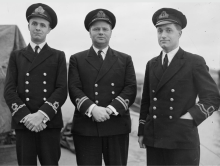
_nurses_at_work_in_the_operating_theatre._MOD_45145977.jpg)
Post-war
From 1938 until 1957, the RNVR provided aircrew personnel in the form of their own Air Branch. In 1947, their contribution was cut to anti-submarine and fighter squadrons only. By 1957, it was considered by the UK government that the training required to operate modern equipment was beyond that expected of reservists and the Air Branch squadrons were disbanded. (The US government took a different view, and the US Navy and Marine reserve squadrons today still operate front-line types alongside the regular units.) The Air Branch was reformed at RNAS Yeovilton in 1980, though it is only open to service leavers.
The British naval reserve forces were amalgamated in 1958, and the RNVR was absorbed into the much larger RNR organisation. After 100 years of proud service, the RNVR as a separate professional naval service ceased to exist. Today the majority of Merchant Navy Officers who would have joined the original RNR are now encouraged to join the modern RNR's Amphibious Warfare (AW) Branch. The centenary of the formation of the RNVR was commemorated by the RNR in London in 2003 with a parade on Horse Guards, at which Prince Charles took the salute. The Merchant Navy officers within today's RNR commemorated RNR 150 in 2009.
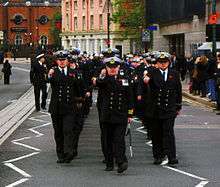
Defence reviews over the last 50 years have been inconsistent. Successive reviews have seen reserve forces cut then enlarged, allocated new roles, then cuts withdrawn, then re-imposed. Options for Change in 1990 reduced the RNR by 1,200 and closed many training centres, including HMS Calpe (Gibraltar), HMS Wessex (Southampton) and HMS Graham (Glasgow). The Strategic Defence Review in 1998 continued this by removing the RNR Cold War mine warfare role, but promised to increase the RNR by 350 posts. The restructured RNR was designed to "provide an expanded pool of personnel to provide additional reinforcements for the Fleet", mainly in the roles of logistics and communications.
This left the mine-warfare, seaman and diving specialists in "limbo" until the second Gulf War, when the Royal Navy realised it had a pool of reservists with no real sea post. Echoing the Royal Naval Division in the First World War, the Above Water Force Protection branch was formed "from RN reservists with no draft appointment at the outbreak of war." Because of a lack of full-time personnel, mine-warfare and diving has recently returned (in part) to the RNR. Officers and ratings currently serve on active service in Full Time Reserve Service billets throughout the RN, as well as in mobilised posts in Afghanistan, the Middle East, the Balkans and the UK.
Following the disbandment of the associated Royal Naval Auxiliary Service (RNXS) in 1994, the Maritime Volunteer Service (MVS) was formed as a national maritime training organisation with charitable status. It has taken over and expanded many RNXS roles.
Commodore RNR Melanie Robinson was appointed the first female Commodore Maritime Reserves (COMMARES) on 4 February 2020.[6]
Branding controversy
Since the Royal Navy rebrand in 2003 that cost circa £100k,[7] the Royal Naval Reserve has been without its own logo; when one is required, the Royal Navy logo is used with the word Reserves added below, and there is no logo for the entire Maritime Reserve. The older Royal Naval Reserve logo is still used as the watermark for passing out certificates issued to Royal Naval Reserve ratings at HMS Raleigh.[8]
Trades and specialisations
All RNR personnel, regardless of rank, enrol as general service before being later assigned to a branch of service. RNR Officers join as a General Duty Reserve, and specialise after commissioning and passing their Fleet Board[9] while RNR Ratings join as General Entry and specialise after basic training.[10]
Most branches are open to both ratings and officers with the exception of fleet protection (ratings only) and a small number which recruit exclusively from the officer ranks. Listed below is a breakdown of branches and the sub-specialisations which are aligned to each branch.
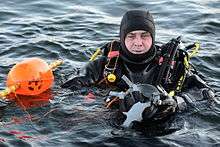
New Entry Branch
- New Entry Ratings
- Ab Initio Officer Cadets
Warfare General Service Branch
- Maritime Trade Operations
- Diving (Under Water Force Protection)
- Mine Warfare
- Information Systems
- Information Operations
- Amphibious Warfare
- Submarine Operations
- Above Water Force Protection
- Media Operations
Intelligence Branch
- Defence Intelligence
- Imagery Analysis
- Operational Intelligence
- Human Intelligence
Chaplains Branch
- Royal Navy Chaplaincy Services
Air Branch (ex-regular)
- Flying Operations
- Operational Support
- Air Engineering
Engineering Branch
- Marine Engineering
- Weapon Engineering
URNU and Sea Cadet Corps
University Royal Naval Unit (URNU)
The University Royal Naval Units, although under the jurisdiction of BRNC Dartmouth, are also an honorary part of the Royal Naval Reserve.[11] Students hold the rank of officer cadet (OC), and can be promoted to honorary midshipman RNR provided they have completed the issued 'Taskbooks' to the satisfaction of the commanding officer of each unit. URNU OCs can now undergo the Accelerated Officer Programme (AOP) to become full RNR Midshipmen. They can then decide to continue on to their RNR Unit or be seconded back to their URNU unit for the duration of their university studies. Training Officers attached to URNUs are appointed as temporary officers in the RNR, without commission or call-up liability.[12]
Sea Cadet Corps (SCC)
As nominal members of the RNR (SCC RNR), officers of the Sea Cadet Corps and the RN CCF Combined Cadet Force retain the use of the former RNVR 'wavy navy' lace. However, unlike their traditional RNVR counterparts[13], they are civilians and as such, do not come under General Trained Strength and are not liable to be called up or deploy.[14]
Officers receive a Cadet Forces commission, introduced in 2017 and restated in 2018;[15] previously they were appointed within their respective Corps, rather than commissioned (unless they also held a commission as officers within the RNR) and titled ‘SCC RNR’ to differentiate from the mainstream Royal Naval Reserve.
Units
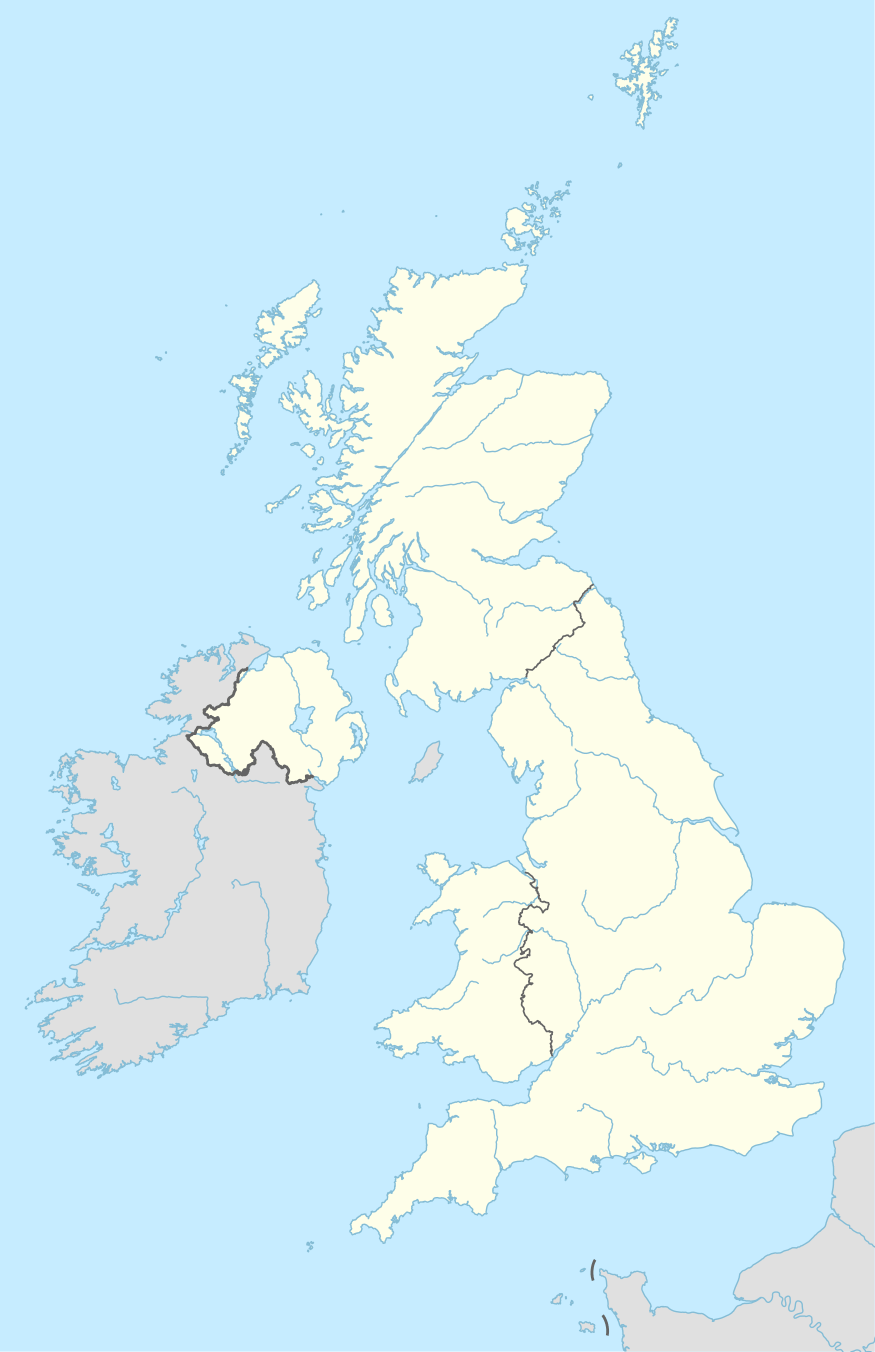
The modern RNR has fifteen Royal Naval Reserve Units (with three satellite units). These are:[16]
- HMS Scotia (Rosyth)
- Tay Division (Dundee)
- HMS Cambria (Sully, Wales)
- Tawe Division (Swansea)
- HMS Dalriada (Govan)
- HMS Flying Fox (Bristol)
- HMS Calliope (Gateshead)
- HMS Ceres (Leeds)
- HMS President (London)
- Medway Division (Chatham)
- HMS Eaglet (Liverpool)
- HMS Vivid (Devonport)
- HMS Sherwood (Nottingham)
- HMS King Alfred (Portsmouth)
- HMS Forward (Birmingham)
- HMS Hibernia (Lisburn)
- HMS Wildfire (Northwood)
- HMS Ferret (Chicksands)
Personnel in the Royal Naval Reserve Air Branch are not attached to a single RNR Unit, but complete their training on regular Fleet Air Arm Units; and are administered through Staff Offices at RNAS Yeovilton and Culdrose.
Previous Units that closed due to recommendations in Options for Change:
- HMS Pellew (Exeter)
- HMS Wildfire (Chatham)
- HMS Salford (Manchester)
- HMS Dragon (Swansea)
- HMS Wessex (Southampton)
- HMS Sussex (Brighton)
- HMS Calpe (Gibraltar)
- HMS Graham (Glasgow)
- HMS Camperdown (Dundee)
- HMS Claverhouse (Edinburgh)
Notable members
The RNR had an exceptional war record, as evidenced by the dozen Victoria Crosses awarded in WWI; and demonstrations of exceptional merit continued in peacetime.
- Lieutenant Commander Richard Baker (broadcaster) OBE RD RNR (formerly RNVR) – broadcaster (first BBC newsreader), actor, musician, author
- Commodore Sir James Bisset, CBE, RD, RNR, LL.D. British merchant sea captain, Commodore of the Cunard White Star Line (1944–47)
- Sub-Lieutenant Rupert Davies RNR – BBC TV's 'Inspector Maigret'
- Midshipman Ben Fogle RNR – broadcaster and writer, held the honorary rank of Midshipman[17] in Southampton University Royal Naval Unit.[18]
- Lieutenant Donald Cameron VC RNR – commander of Midget Submarine X.6 during the attack on the German battleship Tirpitz in 1943
- Lieutenant Commander Ian Fraser VC, DSC, JP, RD RNR – VC awarded as CO of HM Midget Submarine XE-3 attacking Japanese heavy cruiser in Johore Straits. Last surviving naval VC from World War II.
- Commodore Sir Bertram Fox Hayes KCMG DSO RD RNR – Commodore White Star Line
- Honorary Captain Sir Robin Knox-Johnston, CBE,RD*, RNR – the first person to sail solo non-stop around the world[19]
- Commander Charles Lightoller DSC, RD RNR – senior surviving deck officer from RMS Titanic; took his own yacht to Dunkirk evacuation in 1940 aged 66
- Group Captain Adolph Malan DFC, DSO RAF – fighter pilot in Battle of Britain; former Master Mariner, Sub-Lieutenant RNR (1932–36)
- Commodore Sir Charles Matheson DSO RD RNR – Commodore Orient Line
- Honorary Commander[20] Penny Mordaunt RNR – Conservative Member of Parliament for Portsmouth North and Secretary of State for Defence in 2019
- Surg Cdr Andrew Murrison RNR – Conservative Member of Parliament and since 2014 Parliamentary Under-Secretary of State at the Northern Ireland Office
- Frederick Parslow VC – a Mercantile Marine Master given a posthumous commission in the RNR and VC in 1919 for his courage in command of a horse transport ship that was attacked by a U-boat off Ireland in 1915
- Daniel Poole – a recipient of the Distinguished Conduct Medal during World War I[21]
- Captain Sir Samuel Robinson KBE RNR – Captain, Empress of Australia; rescue work at Yokohama after 1923 Great Kantō earthquake.[22]
- Captain Edward John Smith RD RNR – held the rank of commander within the RNR. He was captain of the White Star Line ships RMS Olympic and RMS Titanic, among others.
- Captain Ronald Niel Stuart VC DSO RD RNR – Holder of US Navy Cross, Commodore Canadian Pacific Steamships[23]
- Sir Ernest Shackleton CVO – Lieutenant RNR, master mariner, explorer
- Capt John Treasure Jones – last Master of RMS Mauretania and RMS Queen Mary
- Dr Attracta Genevieve Rewcastle – first female commissioned officer in the Royal Navy, attained rank of Lieutenant-Surgeon in 1940[24]
- Lt Cdr Sir Keith Speed RD RNR – Conservative Member of Parliament 1968–97 and Navy Minister 1979–81, sacked by Thatcher when refused reductions in RN strength prior to Falklands
- Commodore John Wacher CBE RD RNR – Commodore (Master), P & O Steam Navigation Co Ltd
- Lt Cdr Mike Cumberlege DSO & Bar, Greek Medal of Honour, SOE – murdered in Sachsenhausen concentration camp Feb/March 1945[25]
Selected men of the RNVR
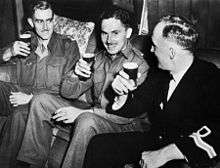
- Ian Fleming, James Bond author/creator, served in Naval Intelligence during the Second World War, reached the rank of commander.
- Alec Guinness, sub-lieutenant commanded a landing craft during the Second World War invasion of Sicily.
- James Robertson Justice actor, invalided out in 1943.
- Laurence Olivier, served as a Fleet Air Arm pilot during the Second World War, reached the rank of lieutenant.
- James Callaghan, joined as ordinary seaman 1942 and left as lieutenant 1945; Parliamentary and Financial Secretary to the Admiralty 1950–51; Prime Minister 1976–79.
- Duncan Carse, 1942–1945, British explorer and actor.
- Erskine Childers, novelist, 1914–1918. Mentioned in Despatches for the Cuxhaven Raid; Distinguished Service Cross for the Gallipoli Campaign.
- Lionel Crabb, (well known as "Buster" Crabb), served World War II as a frogman – RN mine and bomb clearance and MI6 diver.
- A.J. Cronin, served during the First World War as a surgeon.
- James Graham, 6th Duke of Montrose, founder of the Scottish National Party. Founded the RNVR in 1903.
- Sir John Edward Jackson, diplomat.
- Sir Harry Charles Luke, served World War I as commander of the RNVR on the Syrian Coast and as political officer on the staff of Admiral Sir Rosslyn Wemyss, he was awarded the Italian medal for military valour.
- Merlin Minshall, prewar explorer and racing driver, reached the rank of commander.
- Nicholas Monsarrat, frigate commander during World War II, author of The Cruel Sea, reached the rank of lieutenant commander
- Ewen Montagu, served during the Second World War as a lieutenant commander, where he helped conceive Operation Mincemeat, i.e., "The Man Who Never Was"
- Sir Richard Pim, Inspector-General of the Royal Ulster Constabulary.
- Jeffrey Quill, Spitfire test pilot during the Second World War, reached rank of lieutenant commander.
- Denys Arthur Rayner, escort group commander during World War II, author of The Enemy Below, reached the rank of commander
- Ralph Richardson, served during the Second World War, reached the rank of lieutenant-commander.
- C. W. A. Scott served during the Second World War as a lieutenant and was involved in Operation MENACE.
- Peter Scott, served during the Second World War, reaching the rank of lieutenant-commander, and was awarded the DSC and bar.
- Peter Bull, served during the Second World War, commanding a Landing craft (Flak) in the Mediterranean. His memoirs of the war are recorded in "To Sea in a Sieve".
- Sir Lawrence Weaver, architect and founder of National Institute of Agricultural Botany, was an A.B. in the Anti-aircraft service during the First World War.
- Oliver John Whitley, BBC administrator.
- Robert Owen Wilcoxon, brother of actor Henry Wilcoxon, killed in the Dunkirk Evacuation.[26]
- Frank Wild, Antarctic explorer and holder of a four-bar Polar Medal.
- Rodger Winn, intelligence analyst and commander of the Submarine Tracking Room during the Second World War.
- Henry Witherby, Ornithologist and publisher. Served 1917–18 and was mentioned in dispatches.[27]
- Herbert Penny (founder of the Royal Naval Volunteer Reserve in Cape Town which ultimately led to the formation of the South African Navy).
- R.C. Anderson, maritime historian and a founder of the National Maritime Museum, Greenwich, reached the rank of lieutenant-commander during the First World War.
Fictitious characters
- James Bond served in the RNVR, reaching the rank of commander.
- Lawrence Jamieson (played by Michael Caine) in the film Dirty Rotten Scoundrels.
- Ralph Ross Lanyon in Mary Renault's British wartime novel The Charioteer served in the RNVR after being wounded at Dunkirk.
- Henry Root, fictional author of The Henry Root Letters previously served in the RNVR under Captain "Crap" Myers.
- Logan Mounstuart, fictional diarist and author of William Boyd's Any Human Heart, recounts that he served in the RNVR Naval Intelligence Division alongside Ian Fleming throughout the Second World War, reaching the temporary rank of commander.
- Richard Bolton (played by James Caan) in the film Submarine X-1.
- Lt. Comdr. Jeffords (played by James Franciscus) in the film Hell Boats.
- Lt. Cdr. George Ericson RNR in Nicholas Monsarrat's novel The Cruel Sea, played by Jack Hawkins in the film of the same name. Donald Sinden and Denholm Elliott played junior RNVR officers, and Virginia McKenna a WRNS officer. The differences in rank insignia formats are shown very nicely.
Blue Ensign of the United Kingdom

The Blue Ensign of the United Kingdom has been worn since 1865 by British-registered merchant vessels commanded by active or retired officers of the RNR, when authorised by Admiralty warrant. The flag dates from 1801; this usage dates from 1865.
Colonial Reserves
A number of RNR formed before World War II:
- Straits Settlements Royal Naval Volunteer Reserve – c. 1934
- Ceylon Royal Naval Volunteer Reserve – c. 1937
- Malayan Volunteer Reserve – c. WWII
Commonwealth Naval Reserve Forces
There are also naval reserve forces operated by other Commonwealth of Nations navies, including the Royal Australian Naval Reserve (RANR), the Royal New Zealand Naval Volunteer Reserve (RNZNVR), and the Canadian Forces Naval Reserve. Previously there were also colonial RNVR units, such as the Newfoundland Royal Naval Reserve, Ceylon Royal Naval Volunteer Reserve (CRNVR), Hong Kong Royal Naval Volunteer Reserve (HKRNVR), Straits Settlements Royal Naval Volunteer Reserve (SSRNVR) and the South African Division of the RNVR.
See also
References
- Sondhaus, Lawrence (2004). Navies in Modern World History. Reaktion Books. p. 27. ISBN 9781861892027.
- Howarth, Stephen. The Royal Navy's Reserves in War and Peace, 1903-2003 . Leo Cooper, 2003
- "Casualty Details – Victor Joseph Benoit". Commonwealth War Graves Commission. Retrieved 13 March 2010.
- Howarth, Stephen. The Royal Navy's Reserves in War and Peace, 1903-2003 . Leo Cooper, 2003
- Howarth, Stephen. The Royal Navy's Reserves in War and Peace, 1903-2003 . Leo Cooper, 2003
- "New Commander of Maritime Reserves assumes command". Royal Navy. Portsmouth. 4 February 2020. Retrieved 6 February 2020.
- Smith, Michael (29 September 2003). "Navy pays out £100,000 to run up Saatchi flag". ISSN 0307-1235. Retrieved 29 June 2020.
- "Lifetime mum so proud after son's award-winning passing out parade!". Lifetime. 30 July 2013. Retrieved 29 June 2020.
- "https://www.royalnavy.mod.uk/careers/royal-naval-reserves/what-could-you-do/reserve-general-entry-officer". External link in
|title=(help) - "https://www.royalnavy.mod.uk/careers/royal-naval-reserves/what-could-you-do/reserve-general-entry-rating". External link in
|title=(help) - "New location for University Royal Navy Unit | Royal Navy". www.royalnavy.mod.uk. Retrieved 18 May 2020.
- "University Royal Naval Unit". www.royalnavy.mod.uk. Retrieved 18 May 2020.
- "RNVR Unit Histories".
- "Gov UK - Cadet Forces Commission" (PDF).
- "No. 62208". The London Gazette (1st supplement). 20 February 2018. pp. 3146–3147.
- e3. "The Royal Navy Reserves – Royal Navy". Retrieved 28 July 2016.
- https://www.royalnavy.mod.uk/news-and-latest-activity/operations/united-kingdom/university-training
- "Ben Fogle: "I remember" - Reader's Digest". www.readersdigest.co.uk. Retrieved 18 May 2020.
- The London Gazette, www.thegazette.co.uk, 27 October 2015
- "Former Defence Secretary Joins Military Charity | Pathfinder International". Retrieved 18 May 2020.
- Foldi, N.S. (1978). Poole, Daniel (1882–1959)'. Australian Dictionary of Biography, Volume 11, Melbourne University Press, p. 255. Retrieved on 9 August 2009.
- "Captain S. Robinson of the 'Empress of Asia' (1913) (G10732)". National Maritime Museum, Greenwich. Archived from the original on 6 March 2009. Retrieved 13 March 2010.
- "Obituary: Captain Ronald Neil Stuart", The Times (London). 9 February 1954.
- The Examiner. "The Navy's Woman Doctor". Retrieved 2 February 2016.
- Robin Knight (10 November 2018). The Extraordinary Life of Mike Cumberlege SOE. Fonthill Media. GGKEY:NK1G8PK99CQ.
- Gardner, W. J. R. (1949). The Evacuation from Dunkirk: 'Operation Dynamo' 26 May – 4 June 1940. London: Routledge. ISSN 1471-0757.CS1 maint: ref=harv (link)
- Who Was Who. OUP.
External links
| Wikimedia Commons has media related to Royal Naval Reserve. |